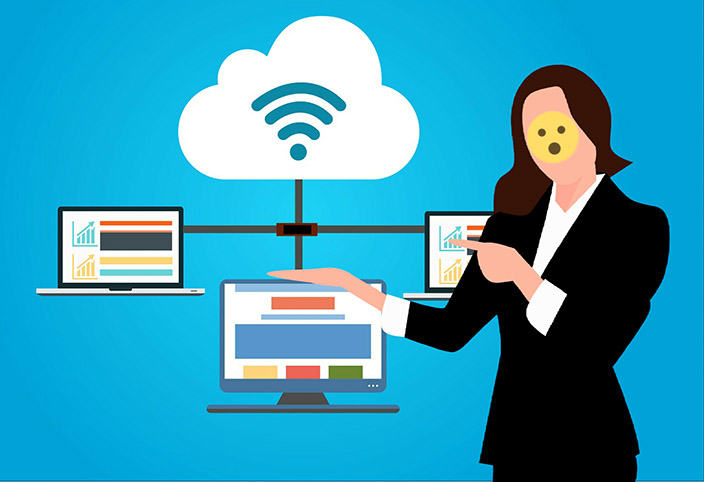
What are Cloud services? An overview of Cloud computing
You might have heard of the term “cloud services” being thrown around lately. Until now, it was common for services to be unavailable without purchasing hardware or installing software on a PC. However, with the advent of the cloud, there are a number of services usable without purchasing hardware or installing the software.
These services that can be used without purchasing hardware or installing software are called cloud services.
There are various theories as to why it is called a cloud. One of them is that it is an analogy for the internet itself. Since, rather than having physical servers on the premises, you can just request for the service.
Cloud computing is the delivery of on-demand computing resources. This ranges from applications to data centers. It is a pay for use based business model and it has recently been very popular. The word cloud is a metaphor for the internet itself.
Its popularity is because of the hassles of managing all these things and also focusing on the business at the same time. At this point, it simply makes more sense to let somebody else take care of all of it. Cloud service providers offer different computing services ranging from hardware such as storage, GPUs etc. to software applications.
Understanding Cloud services with an example
Consider these two examples for mail services.
Scenario 1 (non-cloud services)
Until the last decade or so, email software such as Outlook or Thunderbird were installed on a computer and emails were sent. If you are using it in your company, it may seem obvious that you can use it without doing anything special. However, before you can use it, you need to install it, build a mail server, and so on. As a result, it becomes a difficult task to set it up and maintain it in the first place. In many cases, information system personnel are responsible for this task.
Scenario 2 (cloud services)
Typical email services provided as cloud services include Google’s Gmail and MSN’s Hotmail.
Even without a mailing software installed on your computer, you can still use email through a browser such as Google Chrome or Internet Explorer (IE) as long as you have an account.
If you think about the concept itself, you can use the service only when you need it through the Internet even if you don’t have the software. This is a basic example of software-based cloud service.
How the Cloud originated
The word “cloud” or “cloud computing” is attributed to Eric Schmidt, the CEO of Google in 2006. However, the question is, why cloud computing was born in the first place. Let us first consider the history of computers.
We can divide the history of computers into four eras.
- Mainframe era (ca. 1950-1990)
- Client / server era (ca. 1990-2000)
- Web computing era (ca. 2000-2010)
- Cloud computing era (ca. 2010- )

Mainframe computers
The world’s first commercial computer, UNIVAC I, appeared around 1950, and the mainframe era began around this time. Mainframes are large computers that were very expensive at the time. The large computer (mainframe) had all the functions and it was used by many users simultaneously.
Also, on the mainframe, it was not possible to operate with GUI (Graphical User Interface), and all operations with letters and numbers were necessary.
Client/Server era
In the 1990s, it will change to the
The client side also has a computer to speed up the process, and the tendency to “decentralize” rather than “concentrate” on one machine has become stronger. As a result, managing distributed processing and data has become another issue.
Web computing era
In the late 1990s, a period called the Web computing era began. In this era, the price of computers will become even lower, and the hurdle of adoption will become lower and lower. The networks that had been an issue up to now have not only lowered prices but also improved speed. As a result, the number of computers used becomes huge, making it difficult to distribute all applications and data in the computer.
Web browser solves these problems. By accessing the server and data through a web browser, it is not necessary to distribute the applications and data to all the computers.
Cloud computing era

However, with the rapid increase of services, many servers were in a mess, and this time the challenge was how to manage and integrate servers.
The method needed to solve this problem is “cloud computing”.
Why is cloud computing suitable for server consolidation?
Let us look more specifically at what cloud computing is.
In the first place, cloud computing is realized by a hypervisor (virtualization technology). Hypervisors can virtually create multiple servers on one physical server. Since these servers don’t have independent physical existence of their own, they are called “virtual servers”. Also, the hypervisor creates environments close to physical servers. With the advent of virtual servers, we can now use space to operate multiple virtual servers in the same space as one physical server. So you can see why we consider Cloud computing suitable for server consolidation. After all, data centers handle most, or all of the load and responsibility of server consolidation.
A data center is a facility where servers and network devices are installed. In addition, they also provide and manage power supplies, connection lines, and other things needed to run the system smoothly.
Virtualization has also made it possible to provide cloud services that allow you to use servers (infrastructure) as often as you like.
Classification of Cloud Services
Also, there are several types of cloud services. The above was an example of SaaS, Software as a Service.
On the basis of Service, the following are some examples of typical cloud based services:
IaaS
Infrastructure as a Service (IaaS) consists of the basic elements of the cloud. Basically, it typically provides access to networking functions, computers (virtual or dedicated hardware), and data storage areas. Infrastructure as a Service brings IT resources with the highest degree of flexibility and control. At the same time, it uses the systems most similar to the existing IT resources familiar to many current IT departments and developers. As a result, it is easy for experienced developers and solution architects to make the switch when required.
PaaS
Platform as a Service (PaaS) allows you to focus on application deployment and management. They do so by eliminating the need to manage the underlying infrastructure (usually hardware and operating systems) within your organization. You can work more efficiently by not having to worry about resource sourcing, capacity usage planning, software maintenance, patching, or other annoying tasks associated with running an application.
SaaS
With Software as a Service (SaaS), you only have to think about how to use specific software. In other words, you don’t need to bother about how to maintain the services. Furthermore, even managing the underlying infrastructure is the responsibility of the service provider. For example, a common SaaS application is a web-based email service. Such services can send and receive email without managing additional features to the email product. So there is no need for the companies themselves to maintain the server or operating system running the email program.
Cloud deployment models
Based on Location and ownership, clouds can be classified into the following:
Private
All the computing infrastructure is
Public
The company offering the cloud service owns and manages the entire infrastructure. So, the cloud computing company divides up their resources and allocates them to the clients on a
Hybrid
Usage of both public and private clouds. This depends on the purpose. For example, you may want to host your most important applications on your own systems and host the secondary applications elsewhere.
Community cloud
This refers to a cloud shared between different teams or organizations. For example, social organizations, research institutes, etc.
Cloud Usage Applications for business needs
There are many applications of cloud computing which can be used in businesses. Here are some examples of the various applications.
Application-specific solutions
- Backup and recovery
- Block chain
- Business application
- Content delivery
- Data Analysis
- Data Archiving
- E-commerce
- Hybrid cloud architecture
- IoT
- Mobile service
- Scientific calculations
- Website
Industry-specific solutions
Here are some popular solutions. (Most of them are also listed on the AWS website)
- Automobile
- Digital marketing
- Educational institution
- Enterprise applications
- Financial services
- Game development
- Governments/Administrative organizations
- Manufacturing
- Media and entertainment
- Medical and life sciences
- Non-profit organizations
- Oil and gas
- Power company
- Retail business
- And so on
Some popular Cloud Service Providers
Conclusion
In this article, we looked through the history of cloud computing, some popular models and some applications of cloud computing. I hope this article was useful to you.
